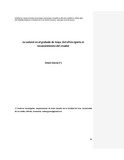Mostrar el registro sencillo del ítem
Lo autoral en el grabado de Goya. Del oficio ignoto al reconocimiento del creador
| dc.rights.license | http://creativecommons.org/licenses/by-nc-sa/3.0/ve/ | es_VE |
| dc.contributor.author | García, Edwin | |
| dc.date.accessioned | 2018-12-06T21:53:49Z | |
| dc.date.available | 2018-12-06T21:53:49Z | |
| dc.date.issued | 2018-12-06 | |
| dc.identifier.issn | 0798-3069 | |
| dc.identifier.uri | http://www.saber.ula.ve/handle/123456789/45476 | |
| dc.description.abstract | El grabado fue durante siglos una disciplina de carácter servil cuya funciona era la de ilustrar textos o reproducir imágenes de carácter denotativo por lo que la figura del grabador era considerada la de un artesano hábil, capaz de convertir una imagen en matriz para luego reproducirla mecánicamente un determinado número de veces. Sin embargo, encontramos entre los siglos XVIII y XIX a la figura de Francisco de Goya, un excepcional grabador español que fue capaz de elevar el carácter meramente reproductivo del grabado en metal y convertirlo en un lenguaje plástico autónomo, con características plásticas de altísimo valor estético y con una carga conceptual de profunda mirada incisiva, lo que se puede aseverar como una superación de las limitaciones técnicas y temáticas del grabado en metal hasta la fecha, para ser convertido en una disciplina artística plena y completamente autosuficiente. En este sentido, se aborda la idea de autoralidad expuesta por Terrosi, concepción que indica el reconocimiento de la autoría de la obra, es decir, la valoración del trabajo del artista como autor y no como simple artífice. Se exponen aspectos por los cuales Goya logró superar la condición de artífice que aun imperaba para la época, al menos en el terreno de las artes gráficas, y alcanza el reconocimiento oficial como creador más allá de la obra pictórica en función del alcance de su obra seriada. | es_VE |
| dc.language.iso | es | es_VE |
| dc.rights | info:eu-repo/semantics/openAccess | es_VE |
| dc.subject | Grabado | es_VE |
| dc.subject | Autoralidad | es_VE |
| dc.subject | Artista | es_VE |
| dc.subject | Artífice | es_VE |
| dc.subject | Reconocimiento | es_VE |
| dc.title | Lo autoral en el grabado de Goya. Del oficio ignoto al reconocimiento del creador | es_VE |
| dc.type | info:eu-repo/semantics/article | es_VE |
| dc.description.abstract1 | The engraving was for centuries a discipline of servile character whose functioning was that of illustrate texts or reproduce denotative images so the figure of the engraver was considered to be that of a skillful artisan, capable of turning an image into matrix to then reproduce it mechanically a certain number of times. Without However, we find between the eighteenth and nineteenth centuries the figure of Francisco de Goya, an exceptional Spanish engraver who was able to raise the character merely reproduction of metal engraving and convert it into an autonomous plastic language, with plastic characteristics of high aesthetic value and with a conceptual load of deep incisive look, which can be asserted as an overcoming of the technical and thematic limitations of metal engraving to date, to be become an artistic discipline fully and completely self-sufficient. In this sense, the idea of autorality exposed by Terrosi, a concept that indicates the recognition of the authorship of the work, that is, the evaluation of the work of the artist as an author and not as a simple artificer. Some aspects are exposed by which Goya managed to overcome the status of artisan that still prevailed for the time, at least in the field of graphic arts, and reaches official recognition as a creator beyond of the pictorial work according to the scope of his serial work. | es_VE |
| dc.description.colacion | 32-41 | es_VE |
| dc.description.email | edwin.gama@gmail.com | es_VE |
| dc.description.frecuencia | Cuatrimestral | |
| dc.identifier.depositolegal | pp1991102ME302 | |
| dc.publisher.ciudad | Mérida | |
| dc.publisher.pais | Venezuela | |
| dc.subject.institucion | Universidad de Los Andes | es_VE |
| dc.subject.keywords | Engraving | es_VE |
| dc.subject.keywords | Authoring | es_VE |
| dc.subject.keywords | Artist | es_VE |
| dc.subject.keywords | Architect | es_VE |
| dc.subject.keywords | Recognition | es_VE |
| dc.subject.keywords | Autonomy | es_VE |
| dc.subject.seccion | Revista Fermentum: Artículos | es_VE |
| dc.subject.thematiccategory | Artes y Humanidades | es_VE |
| dc.subject.tipo | Artículos | es_VE |
| dc.type.media | Texto | es_VE |
Ficheros en el ítem
Este ítem aparece en la(s) siguiente(s) colección(ones)
-
Fermentum - Año 028 - Nº 81
enero - abril 2018


